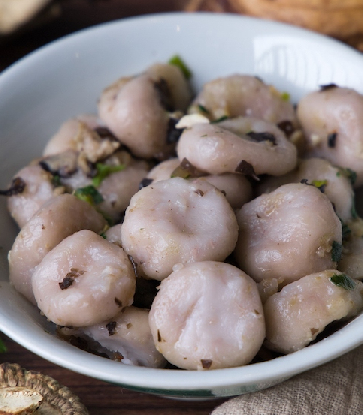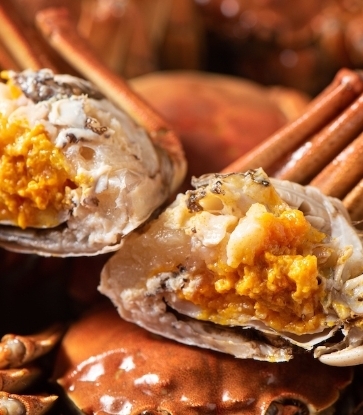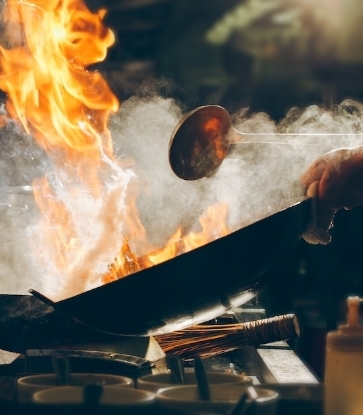Every so often, a fresh debate erupts over just how to make fried rice, that seemingly simple Chinese restaurant staple well-loved around the world. Google “fried rice recipe” and you’ll receive 381 million hits, each one touting “the BEST fried rice”, “better than takeout!” and endless more.
There is no clear history of the origins of fried rice, although it is widely accepted that it was created and documented in the eastern city of Yangzhou, China somewhere around the 6th century AD. However, the southern province of Guangdong lays claim to the style that is most likely known worldwide, as its Cantonese diaspora spread it far and wide. Rice is a staple grain of the southern provinces like Guangdong, so it makes sense that leftover rice fried with various ingredients would develop in popularity as an easy, economical everyday dish.
We asked homegrown Singapore talents Martin Foo of MICHELIN Plate Crystal Jade Golden Palace and chef-founder Ang Song Kang of one MICHELIN star Chef Kang’s and Bib Gourmand Chef Kang's Noodle House to clear the air on the definitive, perfect fried rice and how to recreate it at home. (Banner image: Crystal Jade fried rice with conpoy and egg white)

Chef Foo, who is also group executive chef of Crystal Jade Culinary Holdings, says, “Generally, fried rice is well-loved by young and old so there are inevitably many iterations on this dish throughout China. Here in Singapore, most Cantonese restaurants serve a version which usually consists of prawns, char siew, eggs, spring onions and raw lettuce among others and this rendition is probably most recognisable.”
He sees it as a dish that every Chinese cook apprentice should master, along with sweet and sour pork and braised ee-fu noodles. “There are many skills required to execute fried rice. This ranges from grasping the amount of oil and when to add the oil appropriately at which stage of cooking, mastering the use of the Chinese ‘wok shovel’; rounded and flat ones, and seasoning,” he expounds.

Chef Ang was just 13 and starting as an apprentice chef when he first tried his hand at fried rice. “My head chef told me to cook it and taste my own dish – that’s the way to learn,” he reminisces. “I was too young to really lift the wok, so I learnt all the other basics like washing vegetables, cleaning, cutting and tending the live fish tanks, while all the time watching the chefs to see how they cooked." (Left image: Chef Ang Song Kang of Chef Kang's, a one MICHELIN star restaurant in Singapore)
What should the perfect fried rice look, smell and taste like?
ASK: At the first bite, you will realise the chef’s skills (or lack of) when tasting the rice. It must have wok hei (breath of the wok) fragrance to draw you in, the rice grains are individual and cooked to the right texture, and it cannot be too oily or dry. When done right, you don’t even need many ingredients to improve the flavour of the dish.
MF: There are a few key things I look out for: it should have wok hei, moist but not wet grains of rice, the egg should coat the rice grains, and not be too oily – it should not leave a stain on the lips.
READ MORE: What is Wok Hei?
Can you use any kind of rice?
ASK: The typical Thai jasmine rice from any supermarket is fine, which you must cook the day before. One tip is to never fry with cold rice right out of the fridge – be sure to take the overnight rice out of the fridge beforehand and warm it up briefly in the microwave. It should be barely warm or at least room temperature when you start cooking, otherwise it won’t be able to absorb the flavours from frying. It’ll be a wasted effort.
MF: I personally prefer aged rice from Thailand. Aged rice refers to rice that has been kept for about a year before it is released for sale. Typically, we get an annual shipment of Thai aged rice in September. Thai aged rice has a lower starch content and therefore absorbs less water during the cooking process and is firmer. It also possesses a more intense ‘rice flavour’ and aroma that new rice lacks. A tip for cooking rice for fried rice is to use about 1kg aged rice to 850g water with about 50g of vegetable oil and 1 teaspoon of salt.

Can you use a non-stick pan instead of a wok at home?
ASK: Yes, you can use a non-stick pan at home which is more convenient. You still need to use some oil to coat the rice grains, and set the fire to as high as you can at home to achieve some wok hei. It must be hot enough to make the rice ‘jump’ in the pan. You know you have made good fried rice when you reach this stage.
MF: Yes, it does make the frying process easier since the rice is less likely to stick to the pan. It is important to note that rice is best fried over high heat until the rice dries up and ‘jumps’ around in the pan – as such, frying rice in a wok over a flame will definitely work better since you can crank up the heat and create that wok hei.
CHECK OUT THIS INDONESIAN RICE DISH: Tracing The Roots Of Nasi Ambeng
What’s your sequence of ingredients into the pan?
ASK: I add the oil, it can be vegetable oil or pork lard (I prefer the latter), then pour in the beaten egg to scramble without overcooking. The rice is added into the simmering egg mixture to be coated so you can see it’s turning a beautiful yellow colour. Add the remaining ingredients and fry patiently until the rice is dry and starting to ‘jump’ in the pan.
MF: At our restaurant, we first fry the rice in oil then add beaten eggs so that each grain of rice is coated with egg and takes on a golden yellow hue so that it resembles an auspicious ‘mound of gold’. The rest of the ingredients are then added to mix thoroughly. Spring onions and raw lettuce strips are added last so that they retain their freshness and crunch. Raw ingredients such as prawn are cooked separately and then added. Once the rice grains are fried till dry and ‘jumping’ around in the wok, the dish is ready.
How about essential seasonings and ingredients?
ASK: I have stopped using salt and instead I substitute fish sauce for its umami and salty flavour. You can add any ingredients like prawn, lap cheong (Chinese sausage) but I like a bit of minced beef and XO chilli sauce in my home cooked version. Hua tiao chiew (Chinese rice wine) is used in restaurants as it works well with the high heat cooking to bring out a deeper fragrance, but at home, your fire will not be high enough to ‘activate’ the hua tiao chiew, so you won’t get the same effect. I’d say it’s not necessary.
MF: For seasonings: salt, chicken powder, sugar and good quality soy sauce. For ingredients: diced prawns, char siew, spring onions and raw lettuce.

What should you never do when making fried rice?
ASK: Don’t overcook your rice or cook it with too much water. The grains will absorb too much water internally and stick together, and won’t separate when frying no matter how hot the pan.
MF: You should never add more oil during the frying process because the rice grains will not absorb the additional oil and you will end up with an oily plate of fried rice with residual oil at the bottom of the plate.
(Right image: Fried Crispy Rice and Orzo Pasta with Prawn and Sakura Ebi from Crystal Jade Golden Palace)





















